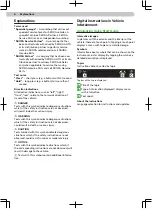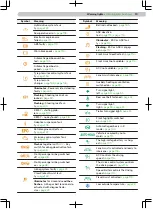
WARNING
▶
The air supply to the electric drive must not be re-
stricted and the electric drive must not be covered
by any additional insulating materials (e.g. by a cov-
er).
WARNING
Risk of an accident!
A vehicle with an electric drive generates low oper-
ating noise when driving. It may not be noticed by
other road users.
Use electrical sockets in the vehicle
Improper handling of the sockets may lead to life-
threatening electric shock or a fire.
▶
The sockets can become warm during operation.
Do not touch warm sockets.
▶
Protect sockets from liquids.
▶
If moisture does manage to get into the power
socket, completely dry out the socket before re-
use.
▶
Do not insert any objects into the socket contacts.
Before your journey
Adults and children, cargo and objects - everything
has its place in the vehicle. Observe the following in-
structions so that all occupants are protected in the
best possible way in the event of an accident.
Before you go
▶
Ensure that you have a good view of outside the
vehicle. Attach external devices (e.g. navigation
system) so that they do not restrict the view exter-
nally.
▶
Adjust the rearview mirrors.
▶
Close all doors and the engine compartment and
boot flap.
▶
Stop the charging process and close the battery
charging flap.
▶
Take up the correct sitting position, adjust the
seats correctly and fasten the seat belt properly.
Ensure that passengers do likewise. Always leave
the seat belt on while driving.
▶
Only one person can be secured with a seat belt.
▶
Make sure that the seat belts are not trapped, e.g.
in the door or in the seat.
▶
Check seat belts, their locks and attachment points
for damage.
Sitting safely
For the safety of the occupants and to reduce the
risk of injury in the event of an accident, the follow-
ing instructions must be observed.
▶
Stand the backrests upright. If the front passenger
seat backrest has been folded forward, only the
seat behind the driver's seat may be used for trans-
porting passengers.
▶
Engage the rear seat backrests correctly.
▶
Adjust the height-adjustable headrest so that the
top of the headrest is as close as possible to the
top of the head.
▶
On the occupied rear seat, the headrest should not
be in the lower position although the upper edge of
the headrest should be at the same height as the
top of the head.
▶
Keep your feet in the footwell.
▶
Use the entire seat.
▶
Do not lean forward or sit to the side.
▶
Do not hold your limbs out the window.
›
Adjust the driver's seat
in the longitudinal di-
rection so that the
pedals can be fully
pushed through with
slightly bent legs.
›
Adjust the steering
wheel so that the dis-
tance
A
between the
steering wheel and
sternum is at least 25
cm.
›
For vehicles with driver's knee airbag, adjust the
driver's seat longitudinally so that the distance
B
from the legs to the dash panel in the area of the
knee airbag is at least 6 cm.
›
Adjust the angle of the backrest so that the steer-
ing wheel can be reached at the top with your arms
slightly bent.
›
Move the passenger seat back as far as possible.
The front passenger must maintain a minimum dis-
tance of 25 cm from the dash panel.
Correct belt webbing arrangement
The webbing arrange-
ment is extremely impor-
tant for the seat belts to
offer the best possible
protection.
▶
The shoulder strap
must run over the mid-
dle of the shoulder,
must never run over
the neck, and must lie
firmly against the body
(it must not run over loose layers of clothing).
▶
The lap belt part must be placed in front of the pel-
vis and fit tightly.
20 Correct and safe › Use electrical sockets in the vehicle
















































